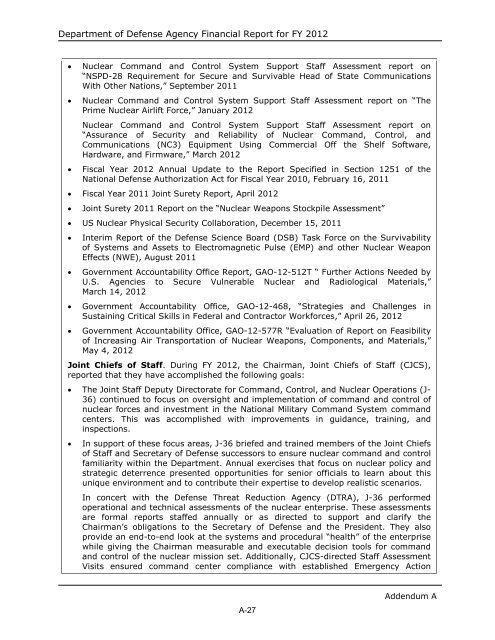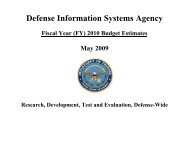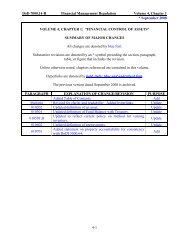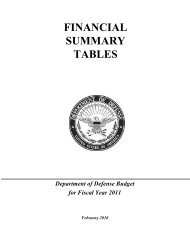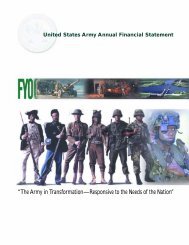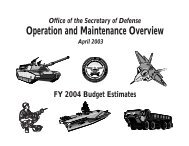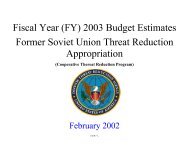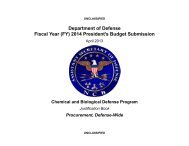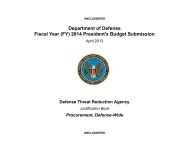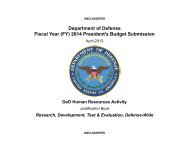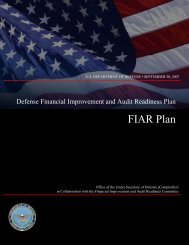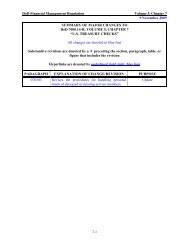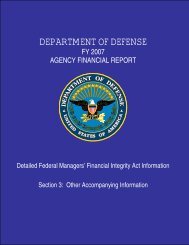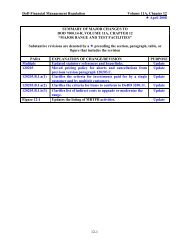department of defense agency financial report fiscal year 2012
department of defense agency financial report fiscal year 2012
department of defense agency financial report fiscal year 2012
You also want an ePaper? Increase the reach of your titles
YUMPU automatically turns print PDFs into web optimized ePapers that Google loves.
Department <strong>of</strong> Defense Agency Financial Report for FY <strong>2012</strong><br />
• Nuclear Command and Control System Support Staff Assessment <strong>report</strong> on<br />
“NSPD-28 Requirement for Secure and Survivable Head <strong>of</strong> State Communications<br />
With Other Nations,” September 2011<br />
• Nuclear Command and Control System Support Staff Assessment <strong>report</strong> on “The<br />
Prime Nuclear Airlift Force,” January <strong>2012</strong><br />
Nuclear Command and Control System Support Staff Assessment <strong>report</strong> on<br />
“Assurance <strong>of</strong> Security and Reliability <strong>of</strong> Nuclear Command, Control, and<br />
Communications (NC3) Equipment Using Commercial Off the Shelf S<strong>of</strong>tware,<br />
Hardware, and Firmware,” March <strong>2012</strong><br />
• Fiscal Year <strong>2012</strong> Annual Update to the Report Specified in Section 1251 <strong>of</strong> the<br />
National Defense Authorization Act for Fiscal Year 2010, February 16, 2011<br />
• Fiscal Year 2011 Joint Surety Report, April <strong>2012</strong><br />
• Joint Surety 2011 Report on the “Nuclear Weapons Stockpile Assessment”<br />
• US Nuclear Physical Security Collaboration, December 15, 2011<br />
• Interim Report <strong>of</strong> the Defense Science Board (DSB) Task Force on the Survivability<br />
<strong>of</strong> Systems and Assets to Electromagnetic Pulse (EMP) and other Nuclear Weapon<br />
Effects (NWE), August 2011<br />
• Government Accountability Office Report, GAO-12-512T “ Further Actions Needed by<br />
U.S. Agencies to Secure Vulnerable Nuclear and Radiological Materials,”<br />
March 14, <strong>2012</strong><br />
• Government Accountability Office, GAO-12-468, “Strategies and Challenges in<br />
Sustaining Critical Skills in Federal and Contractor Workforces,” April 26, <strong>2012</strong><br />
• Government Accountability Office, GAO-12-577R “Evaluation <strong>of</strong> Report on Feasibility<br />
<strong>of</strong> Increasing Air Transportation <strong>of</strong> Nuclear Weapons, Components, and Materials,”<br />
May 4, <strong>2012</strong><br />
Joint Chiefs <strong>of</strong> Staff. During FY <strong>2012</strong>, the Chairman, Joint Chiefs <strong>of</strong> Staff (CJCS),<br />
<strong>report</strong>ed that they have accomplished the following goals:<br />
• The Joint Staff Deputy Directorate for Command, Control, and Nuclear Operations (J-<br />
36) continued to focus on oversight and implementation <strong>of</strong> command and control <strong>of</strong><br />
nuclear forces and investment in the National Military Command System command<br />
centers. This was accomplished with improvements in guidance, training, and<br />
inspections.<br />
• In support <strong>of</strong> these focus areas, J-36 briefed and trained members <strong>of</strong> the Joint Chiefs<br />
<strong>of</strong> Staff and Secretary <strong>of</strong> Defense successors to ensure nuclear command and control<br />
familiarity within the Department. Annual exercises that focus on nuclear policy and<br />
strategic deterrence presented opportunities for senior <strong>of</strong>ficials to learn about this<br />
unique environment and to contribute their expertise to develop realistic scenarios.<br />
In concert with the Defense Threat Reduction Agency (DTRA), J-36 performed<br />
operational and technical assessments <strong>of</strong> the nuclear enterprise. These assessments<br />
are formal <strong>report</strong>s staffed annually or as directed to support and clarify the<br />
Chairman’s obligations to the Secretary <strong>of</strong> Defense and the President. They also<br />
provide an end-to-end look at the systems and procedural “health” <strong>of</strong> the enterprise<br />
while giving the Chairman measurable and executable decision tools for command<br />
and control <strong>of</strong> the nuclear mission set. Additionally, CJCS-directed Staff Assessment<br />
Visits ensured command center compliance with established Emergency Action<br />
A-27<br />
Addendum A


